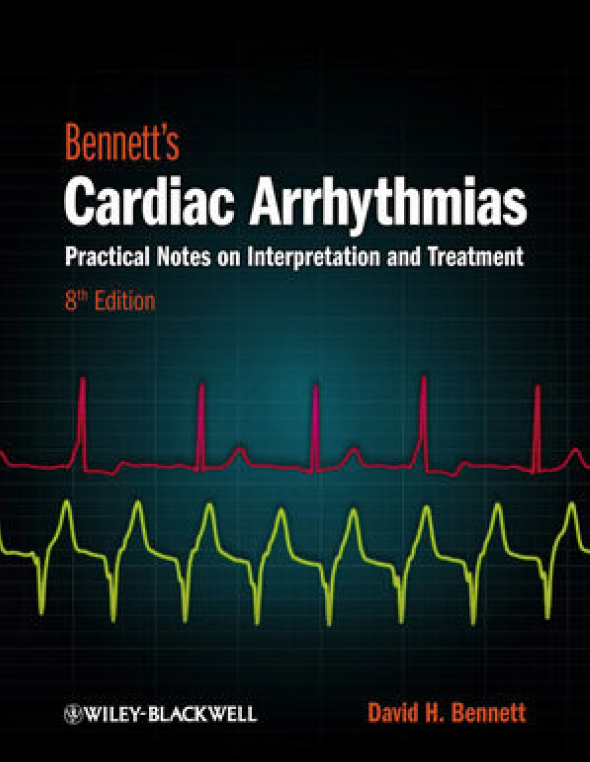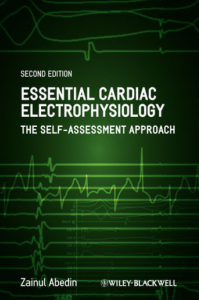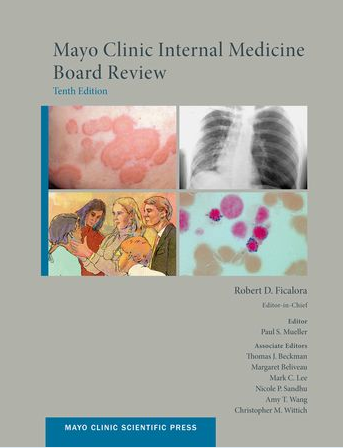Bennett’s cardiac arrhythmias: practical notes on interpretation and treatment, 8th edition
 Author: Bennett DH
Author: Bennett DH
Publisher: Wiley-Blackwell, 2012
ISBN: 978-0-470-67493-2, Price: £34.99
This 8th edition of Bennett’s cardiac arrhythmias offers a comprehensive overview of the mechanisms and management of the most commonly encountered types of arrhythmia in clinical practice. A large variety of good quality examples are provided appended with concise explanatory notes, and the layout is uniform throughout. What is particularly noteworthy and different from a standard book of electrocardiography is the fact that not only does the author outline and exemplify mechanisms and types of arrhythmia, but he also provides an introduction to electrophysiological principles and catheter ablation for arrhythmias.
This is particularly important, since ablation procedures have now become part of the standard level of care offered to patients in tertiary centres. Dealing with patients having to undergo ablation requires a multidisciplinary approach: the team includes the junior doctor (the first to assess the patient), the registrar, the anaesthetist, the consultant performing the procedure, cardiac technicians and, in rare cases, cardiac surgeons. Having a basic knowledge on the fundamentals of an electrophysiological procedure is therefore essential. This book provides a very good guide to those involved in the care of a patient referred for radiofrequency ablation, by offering a solid platform covering everything from the recognition of the problem to the most state-of-the-art treatment that can be offered to the patient.
Other commonly encountered problems on cardiology wards today emanate from patients who have previously received implantable devices, either defibrillators or antibradycardia pacemakers. Early recognition of the most common problems, such as under/oversensing, is essential in the post-implant care of the patient. The basic principles of device functioning and programming are beautifully and clearly outlined in their respective chapters and offer a useful guide for nurses and junior doctors dealing with the post-operative care of these patients to identify the problem early.
Chapters focusing on anti-arrhythmic agents, with details on mechanisms, indications, and recently introduced anti-arrhythmic drugs, including those allowed to be used in pregnancy, as well as arrhythmic problems encountered in athletes, add more to the comprehensive nature of this book.
Last but not least, reference is made to the most recent guidelines, especially with regards to management of atrial fibrillation, the most common arrhythmia. Newly introduced risk scores, as well as new oral anticoagulants are covered. Reference to guidelines for device implantation is equally provided, as well as possible interference and regulations regarding fitness to drive in several case scenarios.
This all makes this book a reference for a large variety of health care professionals and a good foundation for those needing a broad and thorough approach to the diagnosis and the most appropriate management of cardiac arrhythmias.
Irina Suman-Horduna
Clinical Research Fellow
Royal Brompton and Harefield NHS Foundation Trust, London
Essential cardiac electrophysiology: the self-assessment approach, 2nd edition

Author: Abedin Z
Publisher: Wiley-Blackwell, 2013
ISBN: 978-1-4443-3590-3, Price: £42.95
What this book lacks in readability it makes up for in its extensive detail. It will certainly appeal to any electrophysiologist’s interest in electrophysiology (EP) minutiae – from cell physiology to bedside. Small snippets of interesting information appear on every page but it is this attempt to distil huge amounts of knowledge into a relatively small manual that is, in fact, the major downfall of the project.
There are long lists of facts that appear as bullet points beneath chapter sub-sections. There is often no obvious logical connection between these bullet points. This means effective retention of the information is entirely dependent upon memory rather than through any narrative provided by the author to aid understanding.
The book certainly requires a reasonable amount of pre-existing EP knowledge and is not appropriate for healthcare professionals who are not directly involved in the ongoing care of patients with arrhythmic problems.
Where it will be of most use is as a quick reference book for those preparing for professional exams looking to augment their knowledge. The self-assessment sections will also be of use to this cohort.
Overall, credit is certainly due to the author for the exhaustive nature of this publication and I shall certainly keep it on my bookshelf. It’s just a shame the information isn’t conveyed in a more reader friendly format.
Simon Claridge
ST5 Registrar
Queen Alexandra Hospital, Portsmouth Hospitals NHS Trust
Mayo Clinic Internal Medicine Board Review, 10th edition

Editor: Ficalora RD
Publisher: Oxford University Press, 2013
ISBN: 978-0-19-994894-9, Price: £65
On first appearances this book looks like a hefty medical textbook but on reading through it, the content is predominately tables, pictures and bullet point text to provide clear learning points on a wide variety of topics. Each topic is explained in one or two paragraphs, with a bullet point summary, so that the reader can read and then ‘scan’ the details, as the authors suggest. Despite being aimed at physicians preparing for the American Board of Internal Medicine (ABIM) exams, it is ideal reading for the Membership of the Royal College of Physicians (MRCP) exams, especially preparation for its part 2 clinical examination (PACES).
Throughout the book, tables of differential diagnosis lists, as well as the up-to-date management algorithms, are very well written. A few of the chapters, such as those on HIV, infectious diseases and geriatrics, separate it from other MRCP textbooks. The text also contains succinct details on the workings of ventilators providing the candidate with an in-depth knowledge for the question and answer section of the respiratory station. Once familiar with the tables of information, all the data are very easy to revisit and so the book should be kept as a very helpful reference guide. A small ‘question and answer’ book accompanying the main text enables candidates to test their understanding of chapters they have read.
Study suggestions regarding planning, pattern recognition tables and common themes, are also provided which are perfect for a new candidate who is musing on how to approach revision and work efficiently whilst balancing it with normal clinical work. The statistics and genetic chapters are very useful for parts 1 and 2 of the MRCP examinations. I highly recommend this book, which could be used from the start of the MRCP exams and then revisited at each step to develop a staircase approach to knowledge in ‘bite size’ sections.
Julianne Mogford
Academic Clinical Fellow in Diabetes and Endocrinology
Hillingdon Hospitals NHS Foundation Trust, Uxbridge
